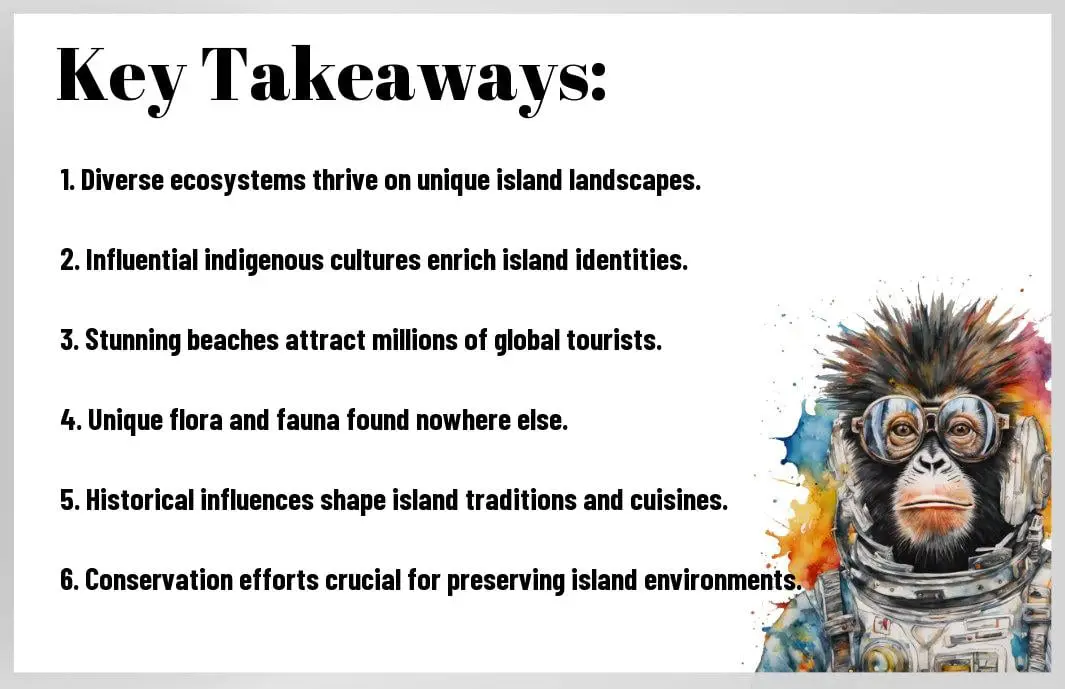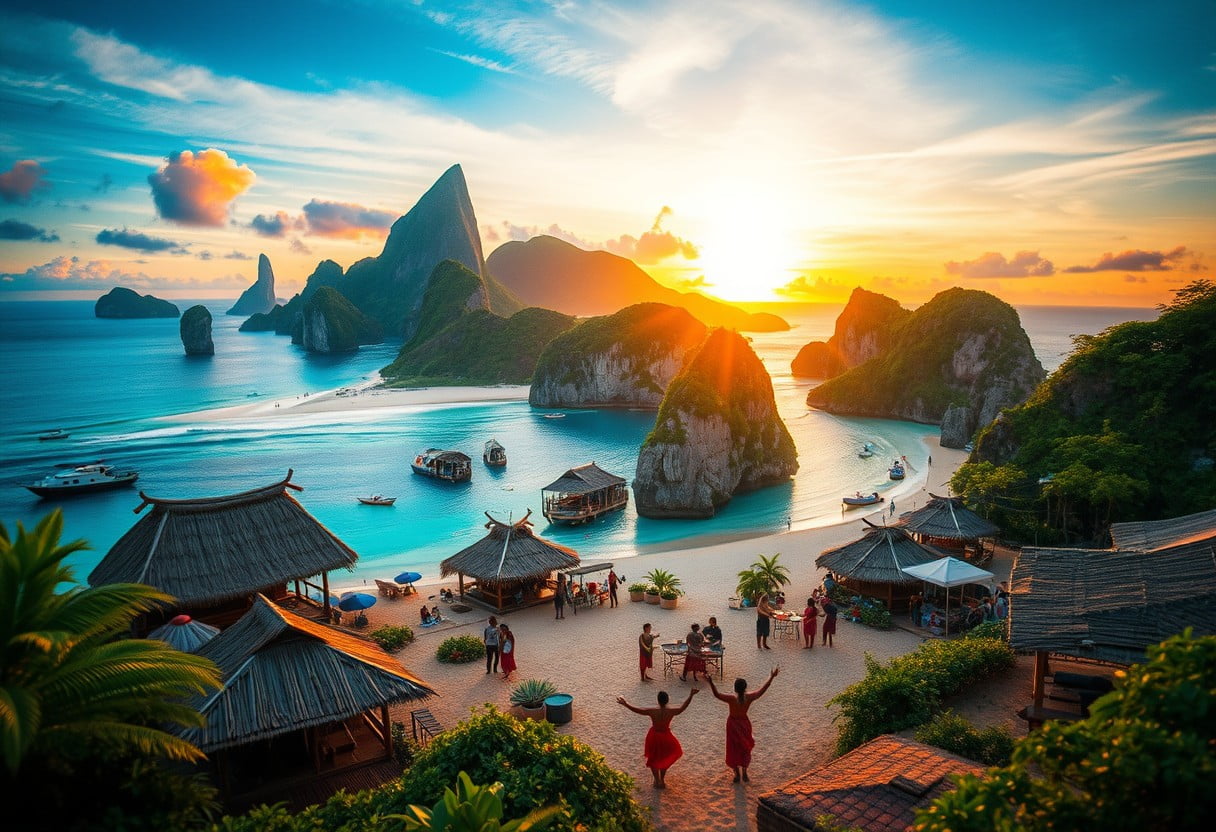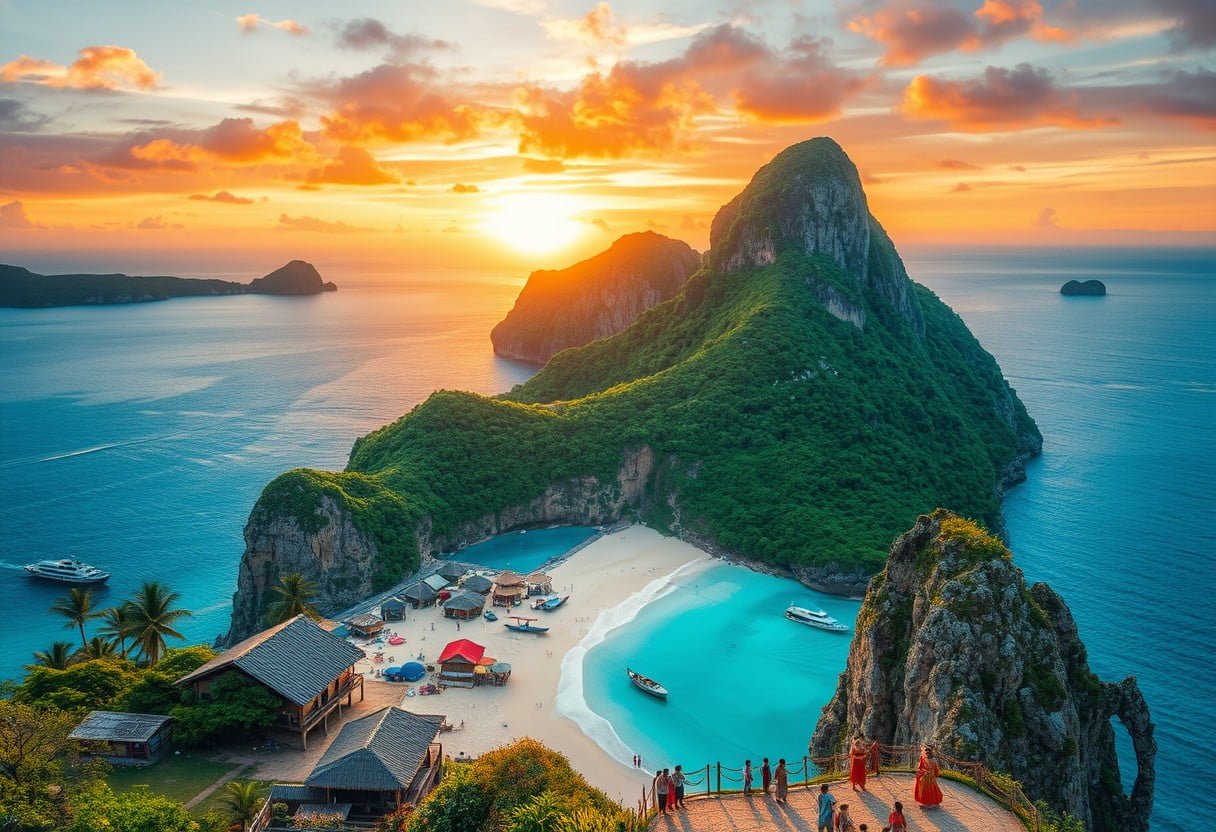Enchantment awaits you as you begin on a journey to explore the world’s most stunning islands, where magnificent landscapes and rich cultures blend seamlessly. In this blog post, you will uncover the unique geography that shapes each island’s charm, from dramatic cliffs to serene beaches. You’ll also examine into the diverse traditions and vibrant histories that define these island nations, offering you a deeper appreciation for the natural beauty and cultural richness that await your exploration. Ready to set sail into the wonders of the world’s islands? Let’s dive in!
Key Takeaways:
- Geographical Diversity: The book explores the unique geographical features of various islands, from volcanic landscapes to coral reefs, highlighting their stunning natural beauty.
- Cultural Richness: It explores into the diverse cultures and traditions of island communities, underscoring their fascinating histories and unique lifestyles.
- Environmental Importance: The text emphasizes the ecological significance of islands, discussing their roles in biodiversity and the challenges they face due to climate change.
- Tourism Impact: The book analyzes the impact of tourism on island economies and cultures, addressing both the benefits and the potential threats to their sustainability.
- Inspiration and Adventure: Through vivid storytelling, the book encourages readers to appreciate and explore these enchanting islands, inspiring a sense of wonder and adventure in island travel.


Defining Islands
The geography of islands offers a captivating glimpse into diverse ecosystems and cultures. When we talk about islands, you’re referring to land masses that are entirely surrounded by water. The Atlantic, Pacific, and Indian Oceans, along with countless seas and lakes, cradle these unique territories. Their sizes can vary immensely, from minuscule islets to vast landmasses like Greenland. Fascinatingly, the intricate configurations of islands can encompass a rich tapestry of cultural, historical, and ecological significance.
Types of Islands
Islands can be categorized into different types based on their formation, structure, and geological processes. Understanding the various types can enhance your appreciation for these stunning locations:
| Type of Island | Description |
|---|---|
| Continental Islands | These are part of a continental shelf and are typically larger. |
| Oceanic Islands | Formed from volcanic activity and are usually isolated from continents. |
| Coral Islands | Created from coral reefs and typically found in tropical regions. |
| Barrier Islands | Coastal islands that protect the mainland from ocean waves. |
| Artificial Islands | Human-made structures for various purposes, often in urban areas. |
Thou can see how these classifications embody the intricate relationship between land, water, and human influence. Each type of island harbors unique characteristics that contribute to its charm and ecological role.
Geographic Significance
Significance of islands extends beyond their beauty; they often serve as significant geographic landmarks. Islands can act as vital waypoints in maritime navigation, historical trade routes, and centers of cultural exchange. Their strategic locations can help protect coastal areas and provide crucial insights into climate patterns and marine environments. As you investigate into your explorations or studies, you’ll notice how islands serve as indicators of the health of global ecosystems, often being the first to show the effects of climate change.
Moreover, islands have also been significant in geopolitics, often serving as territories of contention or collaboration between nations. This unique geographic placement makes them crucial to understanding global interactions.
Biodiversity and Ecosystems
For those fascinated by nature, islands are remarkable for their rich biodiversity and distinctive ecosystems. Isolated by water, many islands have developed unique species of flora and fauna, some of which may not be found anywhere else on Earth. This isolated environment makes islands vital areas for study, as they showcase the principles of evolution and adaptation in action. You may find that visiting these islands not only broadens your understanding of life forms but also the environmental challenges they face.
For instance, many islands are classified as biodiversity hotspots, where conservation efforts are crucial to protect endemic species from threats such as habitat loss and invasive species. These ecosystems contribute significantly to Earth’s overall biodiversity, and your awareness of their preservation can help in global conservation efforts.

Notable Islands of the World
The Maldives: A Tropical Paradise
Notable for its stunning natural beauty and vibrant marine life, the Maldives is a tropical paradise that beckons travelers seeking both relaxation and adventure. With over 1,000 coral islands, this archipelago in the Indian Ocean offers crystal-clear turquoise waters, white sandy beaches, and luxurious overwater bungalows. Imagine sunbathing on the soft sands, exploring the colorful reefs, or indulging in a spa treatment while listening to the gentle waves lapping at the shore. It’s a place where you can immerse yourself in the tranquility of nature.
In the Maldives, culture flourishes amidst the breathtaking landscapes. You’ll find friendly locals, rich traditions, and unique cuisine that showcases the islands’ bounty of seafood and tropical fruits. The vibrant festivals celebrated throughout the year reflect the nation’s Islamic heritage while providing a glimpse into the Maldivian way of life, making your visit not just a retreat, but a cultural experience.
Santorini: A Blend of History and Landscape
Islands like Santorini offer a unique combination of historical depth and mesmerizing landscapes that make them truly remarkable. With its iconic white-washed buildings perched on steep cliffs, this Greek island provides breathtaking views of the Aegean Sea. As you wander through charming streets lined with artful architecture and vibrant bougainvillea, it’s easy to understand why Santorini is one of the most photographed islands in the world. A sunset from Oia is a sight you don’t want to miss, as the sun dips below the horizon, casting a golden glow over the caldera.
Tropical hues blend with ancient ruins and volcanic black sand beaches, creating an atmosphere that is both serene and lively. You can examine into history by visiting archaeological sites like Akrotiri, an ancient Minoan settlement, or explore the local wineries that produce the renowned Assyrtiko wine. This blend of history and beauty ensures that Santorini is not just a destination but an unforgettable experience.
Bora Bora: The Jewel of the Pacific
Santorini is part of a larger narrative of stunning islands globally, such as Bora Bora, often referred to as the jewel of the Pacific. Renowned for its breathtaking lagoon and vibrant coral reefs, Bora Bora in French Polynesia is a haven for water sports enthusiasts. From snorkeling with tropical fish to paddleboarding across serene waters, the island offers a plethora of activities that let you connect with its stunning marine environment. The backdrop of lush green mountains and luxurious resorts enhances the feeling of paradise.
This piece of paradise isn’t only about natural beauty; it’s also a cultural treasure. You can experience Polynesian culture firsthand, from traditional dance performances to savoring local dishes made from fresh ingredients. A visit to Bora Bora promises to be a fusion of adventure and relaxation, making it a must-see for anyone dreaming of tropical escapades.
Madagascar: An Ecological Wonder
Santorini’s picture-perfect settings invite romance and relaxation, while Madagascar stands out as an ecological wonder that invites exploration and adventure. Home to unique wildlife found nowhere else on Earth, this island nation off the southeastern coast of Africa is a biodiversity hotspot. The rainforests, arid deserts, and coral reefs teem with endemic species such as lemurs and chameleons, offering you an incredible opportunity to witness nature’s wonders up close.
This unique biodiversity makes Madagascar a fascinating destination for eco-tourists and nature enthusiasts. You’ll find various national parks and reserves, such as Andasibe-Mantadia and Isalo, where hiking trails and guided tours lead you through stunning landscapes filled with flora and fauna that tell the story of evolution. Madagascar isn’t just an island; it’s an experience that embodies the significance of preserving our planet’s natural heritage.
Landscape diversity in Madagascar includes striking vistas of the Avenue of the Baobabs, surreal rock formations in Tsingy de Bemaraha, and pristine beaches along the coast. Each of these features showcases the island’s incredible terrain and ecological significance, offering you countless options for exploration and adventure during your visit.
Cultural Richness of Islands
Not only do the world’s islands boast stunning natural landscapes, but they also offer a profound depth of cultural richness that captivates visitors. Each island has its unique tapestry of history, traditions, and practices, passed down through generations. In exploring these captivating cultures, you will find that the islands serve as melting pots of indigenous heritage, local customs, and global influences, weaving a vibrant narrative that reflects the identity of their people.
Indigenous Cultures and Traditions
Richness defines the indigenous cultures that inhabit the islands, showcasing an extraordinary connection to the land and sea. From the Maori of New Zealand to the Ainu of Japan’s northernmost islands, diverse ethnic groups have preserved their traditions amidst globalization. You can immerse yourself in their ways of life, witness their rituals, and engage in storytelling that honors ancestral knowledge. These cultures often emphasize sustainability and respect for nature, teaching valuable lessons for the modern world.
Furthermore, indigenous communities celebrate various art forms, such as dance, weaving, and music, which you can experience firsthand through local performances or workshops. By participating in these activities, you gain insight into their values, customs, and artistic expressions that speak volumes about their identities. This deep cultural heritage not only enriches the islands but also serves as an invitation for you to understand diverse perspectives and histories.
Festivals and Celebrations
One of the most exciting aspects of island cultures is their festivals and celebrations, vibrant events that bring communities together and showcase their unique identities. Each island boasts its distinctive festivals, often tied to religious observances, harvests, or seasonal changes. When you participate in these festivities, you witness the locals dressed in traditional attire, engaging in dances, music, and feasts that create a lively atmosphere full of joy and cultural pride.
This explosion of culture during island festivals allows you to experience the essence of their communities. For instance, the Carnival in the Caribbean islands bursts with color and sound, while the Gawai Dayak Festival in Borneo symbolically ushers in the rice harvest with rituals and performances. Being part of these celebrations not only allows you to appreciate the islands’ culture up close but also fosters connections with the islanders, leading to enriching experiences and unforgettable memories.
Culinary Diversity and Island Cuisine
Diversity reigns supreme within the culinary offerings of the world’s islands, each plate telling a story of historical influences, available resources, and community traditions. As you traverse from island to island, you will be delighted by the variations in flavors and ingredients, from tropical fruits and seafood to spices and grains. The beauty of island cuisine lies in its ability to incorporate local elements while also adapting global culinary trends, reflecting the islands’ ever-evolving cultural landscape.
The flavors of island cuisine can be a sensory journey, inviting you to savor dishes rich in heritage and craftsmanship. From the coconut-infused dishes of Fiji to the spicy sambal in Indonesia, your palate will be treated to an array of tastes that celebrate the islands’ natural bounty. Each meal becomes a window into the lives and traditions of the people, allowing you to appreciate not just the food but the stories behind it that have shaped their identity over centuries.
The culinary experience on islands goes beyond just eating; it often involves communal gatherings, shared meals, and cooking traditions passed down through generations. You will find that meals are often a reflection of respect and gratitude towards nature, highlighting the sustainable practices ingrained within island culture. As you savor the diverse dishes, take a moment to appreciate the deep connections between food, identity, and community that this rich culinary heritage encapsulates.
Economic Importance of Islands
Despite their often small size and remote locations, islands play a crucial role in the global economy. The unique geographical features of these landmasses contribute significantly to various sectors, including tourism, fishing, agriculture, and local industries. As you explore the economic landscape of islands, it’s crucial to understand how these factors interlink to support both local communities and broader markets. The economic activities on islands can shape their cultures and resources, making it imperative to recognize their importance on a global scale.
Tourism and Its Impact
The tourism sector is arguably one of the most vital aspects of island economies. Islands with breathtaking landscapes, diverse wildlife, and rich cultural heritage attract millions of visitors every year, creating significant opportunities for local businesses. As you examine deeper into these tourist hotspots, you’ll discover that your visit contributes not only to the hospitality sector but also to ancillary businesses, such as transportation, crafts, and local cuisines. This influx of tourists can lead to job creation and stimulate economic growth, benefiting entire communities.
However, it is also crucial to consider the environmental and cultural impacts of tourism. While your vacation dollars may support local economies, unregulated tourism can lead to overcrowding, environmental degradation, and even the dilution of indigenous cultures. As you enjoy the beautiful islands, it’s crucial to adopt sustainable travel practices that protect these unique environments and allow future generations to experience them as you do.
Fishing and Marine Resources
Any discussion about the economic importance of islands would be incomplete without addressing their rich fishing grounds and marine resources. Fishing is often one of the primary industries supporting island communities, providing livelihoods for many families. As you engage with local fishing practices, you will notice the diverse techniques and species that inhabit these waters, showcasing the rich biodiversity that is vital not only for the economy but also for food security. Sustainable fishing practices play a crucial role in ensuring that these marine resources are available for future generations.
Another important aspect of fishing is its connection to local food culture. You will find that the availability of fresh, locally-sourced seafood enhances the culinary experiences offered on islands, making your visit even more memorable. Additionally, sustainable fishing practices have become vital in preserving marine ecosystems and fostering collaborations among local fishers, conservationists, and governments, further enhancing the socio-economic situation of island communities.
Agriculture and Local Industries
For many islands, agriculture forms the backbone of the local economy, offering food security and employment opportunities for the population. You may find rich volcanic soils and favorable climates on some islands ideal for cultivating a variety of crops, from tropical fruits and vegetables to spices. Local industries often revolve around these agricultural products, with farmers forming cooperatives to enhance their bargaining power and market reach. As you explore these islands, you’ll witness how agricultural practices not only support the local economy but also uphold traditional knowledge and customs.
Local markets frequently showcase the fruits of this labor, allowing you to experience the authenticity of island life while enjoying fresh produce. Engaging with local artisans, craftspeople, and food vendors can deepen your understanding of the culture and traditions that thrive in these communities. By supporting these industries, you play a part in sustaining the local economy and preserving the unique heritage that defines each island.
Environmental Challenges
All of the stunning islands you encounter in your quest for paradise face a multitude of environmental challenges that threaten their beauty and ecosystem. These breathtaking locations, often referred to as the 30 Most Beautiful Islands in the World [2024 edit], are on the front lines of climate change and the consequent ecological issues arising from human activity. Understanding the difficulties these islands face is imperative for anyone who cherishes their unique landscapes and vibrant cultures.
Climate Change and Rising Sea Levels
Rising sea levels are one of the most pressing issues confronting island nations around the globe. As global temperatures continue to escalate, polar ice caps are melting and causing ocean levels to rise, putting many islands—particularly low-lying ones—at risk. You may be surprised to learn that this not only threatens physical land but can also lead to saltwater intrusion into freshwater sources, affecting agriculture and drinking water supplies. Preparing for and mitigating these impacts have become vital for ensuring these beautiful locales remain habitable.
In addition to rising sea levels, changing weather patterns induced by climate change can lead to heavier rainfall and extreme storms, making island ecosystems increasingly vulnerable. For residents and visitors alike, understanding these environmental changes is crucial for fostering a greater appreciation of the challenges at hand and the importance of conservation efforts.
Pollution and Conservation Efforts
Environmental degradation due to pollution poses a serious challenge to the natural beauty and habitats of island ecosystems. You might be surprised to learn that plastic waste, agricultural runoff, and inadequate waste management systems significantly impact the delicate balance that sustains these regions. Islands, often isolated by water, can experience intensified environmental threats, leading to marginalized ecosystems and declining wildlife populations. However, conservation efforts are underway on several fronts, as local communities, activists, and international organizations work together to combat these issues.
For instance, many island nations are implementing strict regulations on waste disposal and establishing marine protected areas to safeguard their rich biodiversity. Initiatives to promote recycling and waste reduction are becoming more common, especially as tourism continues to grow. As you explore these destinations, it’s vital to support local conservation efforts and respect the guidelines set to protect these fragile environments.
The Role of Sustainable Tourism
Climate change impacts and weak infrastructural policies have intensified the necessity for sustainable tourism practices on stunning island destinations. By leveraging tourism as a means to promote conservation, you can help ensure that the natural beauty of these locations is preserved for future generations. Sustainable tourism focuses on minimizing the ecological footprint and instead champions practices that support the local community while respecting and protecting the environment.
Change is in the air, and as a visitor, you have the power to influence the trajectory of how tourism affects these delicate ecosystems. By choosing eco-friendly accommodations, supporting local artisans, and advocating for sustainable practices, you’re not just enhancing your travel experience—you’re also playing a part in ensuring the longevity and vibrancy of these breathtaking islands. Your participation in sustainable tourism can help preserve the rich cultures and stunning landscapes you admire and love.

Future of Island Communities
For island communities, the future is shaped by unique challenges and opportunities that often define life on these beautiful specks of land in the vast ocean. As you explore what lies ahead for these vibrant cultures, it’s important to recognize their resilience in the face of climate change, economic shifts, and social transformations. Embracing adaptation strategies has become not just a necessity, but a hallmark of island living, ensuring that traditions are preserved while they evolve to meet modern demands.
Resilience and Adaptation Strategies
Island communities are often at the frontline of climate change, facing rising sea levels, extreme weather events, and biodiversity loss. Adaptive strategies such as sustainable development, improved infrastructure, and community education are important in enhancing your community’s resilience. By incorporating eco-friendly practices and fostering a deep connection with the natural environment, you’ll find that islanders can safeguard their cultural heritage while also preparing for future challenges. Engagement with local leaders and policies promotes a united front against the threats posed by external pressures.
Island communities also leverage traditional knowledge and practices, employing a unique blend of ancient wisdom and contemporary solutions. This fusion not only strengthens your community ties but also encourages a greater understanding of the natural world. Through the continued adaptation and resilience of islanders, you play a vital role in shaping a brighter, sustainable future for your beloved home.
Technological Innovations in Island Living
Island life often presents logistical and infrastructural challenges. However, technological advancements are transforming how you live, work, and interact with your environment. Innovations in renewable energy, water conservation, and sustainable agriculture are just some areas where technology helps you to enhance quality of life on islands. For instance, solar energy systems and wind turbines allow communities to harness natural resources, reducing dependency on imported fossil fuels and improving energy security.
Island economies are evolving through digital advancements, which promote tourism, fisheries, and agriculture. Smart tourism applications help keep visitors informed while minimizing environmental footprints, ensuring that the delicate balance between preserving natural beauty and enhancing economic growth is maintained. Embracing these technological innovations allows for sustainable practices that contribute to the overall resilience of your island community.
Strategies for adapting to changing conditions can also include the development of smart infrastructure that utilizes Big Data and analytics, empowering local governments and community organizations to manage resources efficiently. Your role in driving these changes is crucial; advocacy for technological adoption can foster awareness and encourage innovation in daily practices.
Global Cooperation for Island Preservation
An important component in the future of island communities is global cooperation aimed at preservation efforts. Collaborating with international organizations, governments, and NGOs can enhance your community’s ability to tackle pressing issues such as climate change and resource management. By sharing knowledge, funding, and innovative solutions, islanders can work together to secure a sustainable and equitable future.
As you engage in dialogues and form partnerships beyond your shores, you create a collective strength that resonates in global policy-making. This interconnectedness can lead to more substantial initiatives that directly support the needs and rights of island populations, fostering resilience and advocating for sustainable practices that echo around the world.
A united front among island communities and global partners can break down barriers, allowing for shared resources and joint initiatives. When you collaborate with others who understand the unique challenges you face, it can lead to effective strategies for ecological preservation and cultural sustainability that benefit all island nations.
Conclusion
Following this exploration of the Islands of Enchantment, you will have gained an appreciation for the incredible diversity found across the world’s stunning islands. Each unique geological formation offers not only breathtaking landscapes but also rich cultural histories and traditions that resonate with their inhabitants. Whether you envision sandy beaches, volcanic mountains, or lush jungles, these islands hold the promise of adventure and tranquility alike. Understanding the geography of these remarkable locations can enhance your travel planning and ensure that you make informed choices that align with your interests, allowing you to fully immerse yourself in the local culture and environment.
As you consider your next getaway, don’t forget that the islands you choose will not only enrich your personal experiences but also contribute to your understanding of some of the most mesmerizing ecosystems on the planet. With this newfound knowledge of both their geography and culture, you are equipped to examine deeper into the stories that each island holds. So go ahead, pack your bags, and let the allure of the Islands of Enchantment guide you on your next unforgettable adventure.







